Creation: Darwinian Evolutionary Frauds Pt. I

A Sunday guest post by my brilliant husband, Gregg.
Every Sunday, my clever husband offers me a “day of rest” by writing posts on the subject of his primary ministry. This is a topic that is gaining more and more attention in our modern culture. The topic, Creationism vs. Darwinism, is a subject that has broad reaching scientific, social, and metaphysical implications. He chooses to conclude each post with a message intended to hearten and bolster believers. However, for believers and non-believers alike, the primary purpose is to present scientific, historical, logical, and/or sociological data in an empirical fashion, as much as possible written in layman’s terms, and in a format suitable for supplementing any homeschool curriculum whether you choose to believe the Biblical account — or secular guesses — about the origins of human life on earth.
Pious Fraud
In the context of debates, a Pious Fraud is very often a lie, a fabrication, or a forgery. More generally, it would be when an emotionally committed speaker makes an assertion that is shaded, distorted, or fabricated from whole cloth. The purpose of the Pious Fraud is to use a false claim to bring listeners to believe as the speaker believes.
In other words, Pious Fraud is a fraudulent act done to result in some “good” end, based on the assumption that this intended end justifies the means. Saint Augustine strongly opposed a fallacious form of argument called Pious Fraud. Around the year 400, he wrote two books, De Mendacio (On Lying) and Contra Medacium (Against Lying), on the subject of fraud, deceit, and lies. He argued that the sin of bearing false witness isn’t found in what one does or does not say, but rather in one’s intent to leave a false impression.
In the context of the Creation vs. Darwinism debates, Darwinists have relied heavily upon Pious Fraud since Charles Darwin first published his racist diatribe entitled “ON ORIGIN OF SPECIES OR THE PRESERVATION OF FAVOURED RACES BY MEANS OF NATURAL SELECTION.”
The sheer number of frauds committed in the name of Darwinism ought to rock objective investigators back on their heels and leave them stunned. Why, I ask, if Darwinian evolution is so very scientific and factual, must it be supported time and again and almost entirely by lies, misdirection, and outright — as in blatant and intentional — fraud?
Whenever these fraudulent actions are revealed, as they inevitably are, Darwinists mockingly assert that “scientists” discovered the fraud. In my mind, this does not excuse the fact that Darwinian scientists perpetrated the fraud in the first place. Then the frauds are quietly swept under a rug until they can be repackaged, dusted off, and perpetrated again.
This is the inaugural post of a new Creation series. The next series of posts will review some of the more blatant frauds committed by Darwinists in the name of their religion, that being secular humanism.
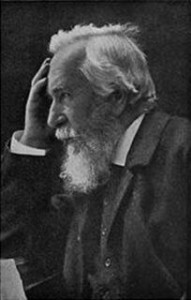
Ernst Haeckel’s Fraudulent Embryo Drawings
Most people have heard of the idea that the human embryo, during it’s early development in the womb, goes through various evolutionary stages, such as having gill slits like a fish, a “vestigial” tail like a monkey, and so on.
This concept — once rather pretentiously and inaccurately called the ‘biogenetic law’ –was popularized in the late 1860’s by German fan of Charles Darwin named Ernst Heinrich Philipp August Haeckel. It is also known as ’embryonic recapitulation’ or the theory that ‘ontogeny recapitulates phylogeny’, meaning that during an organism’s early development it supposedly retraces it’s entire Darwinian evolutionary history.
So, a human embryo is supposed to pass through a fish stage, an amphibian stage, a reptile stage, and so on. Within months of the popular publication of Haeckel’s work in 1868, the drawings were shown to be fraudulent. Haeckel fraudulently modified the drawings of embryos to make them look much, much more alike than they actually do.
Haeckel even printed the same woodcut several times, to make the embryos look absolutely identical, and then claimed they were embryos of different entirely different species (dog, chicken, and turtle).
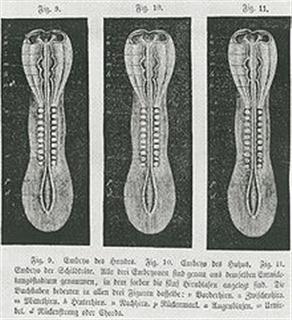 |
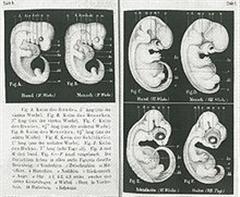 |
The above pictures were used by creating single woodcuttings and using them as a “rubber stamp” to create the pictures of the supposedly diverse species. Unlike unique forms found in nature, they were all quite literally drawn from the same mold.
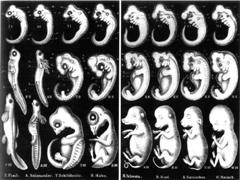 The above picture is one of the most famous of Heackel’s fraudulent drawings depicting many diverse species allegedly right next to each other ending with a depiction of a human embryo. This fraudulent drawing also relies heavily upon the concept of homology.
The above picture is one of the most famous of Heackel’s fraudulent drawings depicting many diverse species allegedly right next to each other ending with a depiction of a human embryo. This fraudulent drawing also relies heavily upon the concept of homology.
Despite exposure as a fraud over a century and a half ago, Haeckel’s woodcuts appeared in textbooks for many years and watered down varients of his drawings often still appear in modern textbooks.
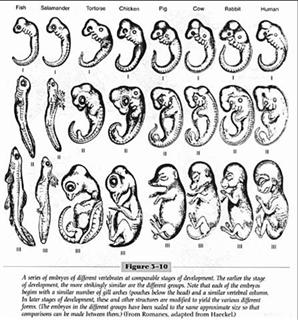 This is one example of a representation from a modern high school textbook.
This is one example of a representation from a modern high school textbook.
As to Heackel’s thesis itself, it has been refuted time and time again. Human beings, for example, never have a gill slit like a fish at any time in our development. What we see there is more like what happens when you try to touch your chin to the middle of your neck. You get a wrinkle in your neck. It has nothing to do with respiration. You don’t breath through the wrinkle and neither to embryos. A fish gill is a remarkably complex organ. Likewise, we are never cold-blooded like a reptile. And there is no such thing as a vestigial organ or bone of any type (that’s another post for another day).
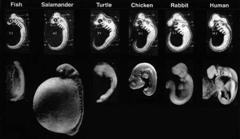 Above, top row: Haeckel’s drawings of several different embryos, showing incredible similarity, in their early ‘tailbud’ stage.
Above, top row: Haeckel’s drawings of several different embryos, showing incredible similarity, in their early ‘tailbud’ stage.
Bottom row: Actual photographs of how embryos really look at the same stage of development.
Vastly different.
So the theory is utterly wrong. Yet, it still appears in textbooks and I have no doubt that someone reading this went, “Really? We never had gill slits like a fish? But they taught me that in school.”
Levels of Fraud
So there are really two levels of untruths being perpetrated. There is Haeckel’s own personal fraud and there is the continuing fraud that is being perpetrated in public schools today, over two hundred years later.
As to his personal fraud, von Haeckel never made a secret of his agenda. He wanted to kill God. He invented this theory to support Darwin’s work and perpetrated these frauds in order to use them as “evidence” he lacked to mock and belittle the Creationists of his day. He did it for fame and fortune. He did it to walk proudly down the halls of the secular humanist movement of his era alongside his numerous secular humanist peers.
You might imagine that we shouldn’t reward fraud and lies, but in this case we certainly have. Haeckel’s thesis is still taught in many schools as fact to this very day even though any and all “evidence” is entirely falsified. For his brilliantly conceived and executed fraud, Haeckel was awarded the Linnean Society of London’s “prestigious” Darwin-Wallace Medal in 1908. Here in the US, and also in also in New Zealand, there are soaring mountains named after Ernst Haeckel.
So, for Haeckel at least, his fraud paid off in long term dividends…an enduring legacy of lies and misdirection based on false evidence. Now to the continuing fraud that is being perpetrated in public schools…what do you think that means?
In recent years, a state law had been proposed that only factual information could go into any textbook. A school board president asked at the committee hearing, “If you remove this material, what do you propose to replace it with?” What do you suppose she meant by that?
Should we wait until someone can gin up a more impressive fraud? Or do we need to just keep this falsified evidence firmly in place until we find even a shred of actual and supporting evidence? In my opinion, we could leave out the lies and frauds and rely upon what we used to call facts and objectivity. But I am not a school board member so what do I know?
You might ask, “What harm does this fraud really result in?” Well, it undermines truth. Is truth still preferable to lies in your worldview? And the fact is that some of Haeckel’s theses became a part of the pseudoscientific basis for Nazism and that particular social movement resulted in the near extermination of the Jews in Europe. That is a very uncomfortable fact for Darwinists, but a fact nonetheless.
Why do you think it is so important that our children be taught this secular humanist lie to be true? What do you think the meaning is there? In the absence of facts, there remains only an agenda. What do you suppose is the intent of that agenda?
The Truth
Personally, we should not tolerate being lied to and, as parents, must not tolerate anyone lying to our children. The truth is that there is no fraud contained in God’s word. God does not need to lie to convince anyone of what He is.
God Bless you and yours.
Gregg
Resources: Additional Posts dealing with Creation and Darwinism


I have to admit Gregg that this is the first of your posts that I read. I always worried I wouldn’t understand them. I decided to read this and was surprised. First I understood what you were talking about and second. I was that person reading who was taught that in high school. Thank you for making the truth known. I am looking forward to your next post!
I also think that if the school board member is worried about putting something in its place. Pictures would bea great option. If they are needing a space filler some pictures would really work great!
Hi Greg, As I secular humanist who believes in evolution, I’d like to say that I strongly oppose the lies described in your post because it goes against the ethos of secular humanism. I’m not sure just how pious Haeckel’s fraud was. It sounds like it was a mixture of pious and selfish, but either way it’s inexcusable. Text books certainly shouldn’t be reproducing those drawings either (except to discuss scientific frauds). In fact, they shouldn’t have been put there in the first place.
As for what the school board president said, I don’t feel I’m in a position to comment because I don’t know the context. I sincerely hope they didn’t mean “What lies shall we put in its place”! She could have meant “given that you need to remove the fraud, what evidence will you put in its place?” I don’t know. I’ve only seen a small snippet of what she did say.
The fact is that some textbooks use photos rather than Haeckel’s drawings to show that closely related species have similar embryos. That is the kind of thing I’d expect to be in its place. I wouldn’t expect them to say that human embryos go through a fish phase (Haeckel’s idea) because that just doesn’t happen.
Science, as with any other human pursuit, has its share of fraudsters. However, the enterprise of science does have a safeguard which is that scientific results need to be reproduced by independent scientists. That’s why I say Haeckel’s drawings shouldn’t be in a textbook. Because they can’t have been reproduced by an independent scientist given that they were a fraud.
What I’d like to ask is whether there are any pious frauds on your side of the fence. What about this claim that the wrinkle in a human embryo is like what happens when you touch your chin to your neck? I think Jonathan Wells makes this point in the book “Icons of Evolution”. My guess is that the embryo isn’t touching its chin to its neck at the time. So it’s different, right? Maybe we could say it develops a pouch temporarily?
May peace be with you, Neil.
Thank you for your comment.
`
I don’t really understand how my remark about the neck folds can be interpreted as fraudulent. By the 28th day of life, the human embryo’s brain and spinal cord have raced well ahead of the rest of the body in growth. Therefore, for a short period of time, the spinal cord is actually longer than the body, forcing the body to curl and flexing the neck area forward.
`
As an aside, this curled up embryo with the long spinal cord is mistakenly accused by some Darwinists of having a “vestigial tail.” This also is not the case, of course.
`
Anyway, just as many human adults develop a double chin when bending the neck forward, so the embryo has folds in its neck area due to this flexing of the developing spinal cord.
`
The so-called gill slits of a human embryo have nothing to do with gills, and as you said, the human embryo does not pass through a fish stage or any other evolutionary stage for that matter. The development of the human embryo reveals steady and methodical progress toward a fully functional human body, almost as if it were designed that way. Never in the course of development does a human embryo absorb oxygen from water like fish do with their gills and the so-called “gill slits” are not even slits. Any informed embryologist can tell you that they are nothing more than folds of tissue that happen to be in the region of the tiny embryo’s throat.
`
Gill slits is a misleading name, since these folds are neither gills nor slits. Another popular and much more authoritative and scientific sounding name for them, branchial arches, is just as deceptive because the word branchial comes from the Greek word for “gills.”
`
Somehow the name “neck folds” just isn’t scientific or authoritative sounding enough for Darwinists, so these folds are also called “pharyngeal arches,” since they are arch-shaped folds near the throat. Pharyngeal meaning things having to do with the throat. The creases between the folds are called pharyngeal clefts, and the undersides of the folds are called pharyngeal pouches.
`
Each fold shapes itself into very specific structures as the fetus develops, none of which are ever used for breathing at any time. The outer and middle ear as well as the bones, muscles, nerves, and glands of the neck develop from these neck folds. They only ever superficially resemble gills.
`
Again, thanks for your remark.
`
Gregg
Hi Gregg,
Thanks for your considerate comment. I hope we can continue discussing in a civilised manner (time permitting).
I must admit I’m not an expert on embryology so this is quite new to me. I agree that human embryos don’t absorb oxygen from water and so the phrase “human gill slits” is misleading.
I’ve been reading a section of Gray’s Anatomy online and figure 42 indicates that the pharyngeal clefts are thicker than the pharyngeal pouches. This isn’t the same as an adult developing a double chin, which is a result of the skin folding back on itself but maintaining its thickness. Also, the section of tissue along the centreline has no folds which I would expect to be there if they were just due to the head being pushed forwards.
The text also discusses gill-bearing animals, birds and mammals together which indicates that the clefts and pouches develop across whole ranges of animals. The correspondence between pouches and gills is direct in fish. These are the points which are being made by supporters of evolution. They aren’t trying to say that humans go through a fish stage.
The wider discussion is about which sources we can trust. I’ve found the TalkOrigins archive to be trustworthy. I understand you might find the content to be unpalatable and I don’t expect you to trust it, but perhaps you could look through the Index to Creationist Claims for the points you’re going to be making before writing your next post. At least then you’ll know what kind of response to expect from a supporter of evolution. Out of interest, which sources do you trust? Have you seen embryos with your own eyes or have you read about them in a book?
May peace be with you, Neil.
Of course it cannot be called a double chin since it is tissue. This is why I used the word “as” to draw the comparison. At that stage of development, there isn’t even a throat. I will write more on this next Sunday, with pictures if that helps.
`
Textbooks, modern textbooks, still make claims to common ancestry based on recapitulation theory. I have seen those since I have and know children attending school.
`
I don’t go to TalkOrigins but it isn’t about trust. More about the intentional ignorance and hostility hosted there.
`
I am not sure what you mean by have I seen an embryo with my own eyes? They are fairly small at the stage of development we are discussing. I have seen my children on an ultrasound. Would I not need some kind of magnifying device or other device? Would a magnified photograph in a book not serve the purpose just as well?
`
God Bless you,
Gregg
Two thoughts:
First, there are lots of naming conventions in biology. I don’t know what they are for anatomy. But names given in earlier times could continue to be used even if they are not literally representative because those words have become the name of that structure. If you had been the first to observe that structure back in the 1800s you might have named it a neck fold, but you weren’t the one to name it. There’s also the issue of translation of the name into other languages. What name do embryologists today generally use for those structures in scientific writing? There needs to be some consensus on the name of a structure in order to communicate.
.
The other thing is that when you judge textbooks, especially ones below college level, you’re likely to be seeing not a direct representation of scientific thinking and wriitng but a very simplified condensed edited version worked on by a textbook company which wants to sell books. If both ‘gill slits’ and branchial arches’ are phrases which have been used in the past, it seems possible to me that the textbook editers would select ‘gill slits’ because the words sound simpler for kids. There is no way even a college biology text can do more than touch on a lot of areas of biology in one book; there is no room to go into the subtleties of the topics. (And the fact that some states have tried to limit the teaching of evolution in biology in the past makes it a topic which the textbook companies might handle gingerly and perhaps as briefly as they can in some of the texts in order to make their textbooks saleable in those states. Again, this means there is less room for detail and clear explanations.)
I knew someone who wrote a chapter for a high school biology textbook. She had no input at all on the illustrations. The textbook company edited her material and handed it over to an art department which choose illustrations that they thought were roughly appropriate and probably were cheap to use. In some cases the reason that the old Haeckel illustration has been used in textbooks might be that some art director looked at other textbooks and used that illustration without consulting the author or any scientists – just for convenience because it was in the common domain and easily usable.
I wonder if you have read what Miller wrote about the use of that picture. I’ve forgotten where, but you could google it. If I recall correctly it was used in his textbook and he took it out. But there is similarity of embryos, even if that 1800s woodcut image was made to misrepresent the actual embryos.
Hello HD,
`
The recapitulation theory was refuted in 1790. No excuse for it to be in textbooks 200 years later. It started appearing in textbooks intentionally after 1962, so only in the last 40 years. Miller knew they were fraudulent as did Stephen J. Gould. Only after it became much more widely known that they were fraudulent were they removed.
`
There are similarities between bb’s and bowling balls and beach balls. There are also a whole heck of a lot of differences. What I am saying is that similarities between similar objects of study doesn’t necessarily prove anything. Why are none of the embryo drawings — even the modern ones by Miller in his Prentice Hall textbooks — drawn to scale? They are scaled to look as if they are all of very similar sizes which is not the case. The answer is that the scale is tweaked in order to emphasis the homology.
`
As to limiting the teaching of evolution — in 1960 there were on average about 220 words dedicated to Darwinian evolution. There are more than 26,000 words honoring Darwinian evolution in the average high school textbook today. Yet SAT scores have plummeted since 1962. Go figure.
Hi Gregg,
I still don’t see how the following description can be seen as accurate: “just as many human adults develop a double chin when bending the neck forward, so the embryo has folds in its neck area due to this flexing of the developing spinal cord.” It seems to me that the clefts and pouches are structures which have grown in a particular shape and go on to develop into different areas of the body. I hope next Sunday’s post will help.
I wasn’t meaning to sound challenging when I asked where you get your information from. It’s okay if you get it from photos in books. I’m just trying to understand your position. I’ve often seen different people adopt different positions because they accept different books as authoritative. I’m wondering if that’s happening here.
Peace be with you, Neil.
FWIW, this post appeared today in the Panda’s Thumb blog.
http://pandasthumb.org/archives/2010/06/haeckel-had-a-p.html
I wish I could subscribe to comments on these posts.
.
.
>>>”There are more than 26,000 words honoring Darwinian evolution in the average high school textbook today. Yet SAT scores have plummeted since 1962. Go figure.”
.
That sounds as if you’re implying a cause and effect relationship. I think that is a logical fallacy.
.
Was 1790 a typo?
.
>>”In recent years, a state law had been proposed that only factual information could go into any textbook. A school board president asked at the committee hearing, “If you remove this material, what do you propose to replace it with?” What do you suppose she meant by that?”
.
I have no idea without knowing more about the discussion. I’m guessing from your question that you have an idea though. What do you think she meant?
hd: On the very bottom, on the left, under the comments box, there’s an option to receive follow up comments via email. Let me know if that doesn’t work.
Oh – and just fyi — Gregg may be out of pocket for a few days. He doesn’t know what his communication is going to be like for the next week or so. I’m hoping he’ll have online access, but just in case you don’t hear from him, you’ll know why.
Thanks Hallee – I did that for a few times and only saw a few emails so I stopped. But I’ll try again. Maybe it depends on whether the response is posted to a particular comment or to the post itself.
(this comment is a reply to Hallee’s comment)
Maybe you need to click that button not after you’ve commented, but before? It could be that it was clicked when you were within “reply to this comment” – then you got only those replies and not replies to the whole thread. I don’t know. Gregg does all that behind the scenes stuff for me. He is the power that keeps the engines running and the grease that keeps the wheels not squeaky – I just type in my little box – lol.
This series is INCREDIBLE! Can’t wait to read your other apologetic articles. Keep ’em coming!